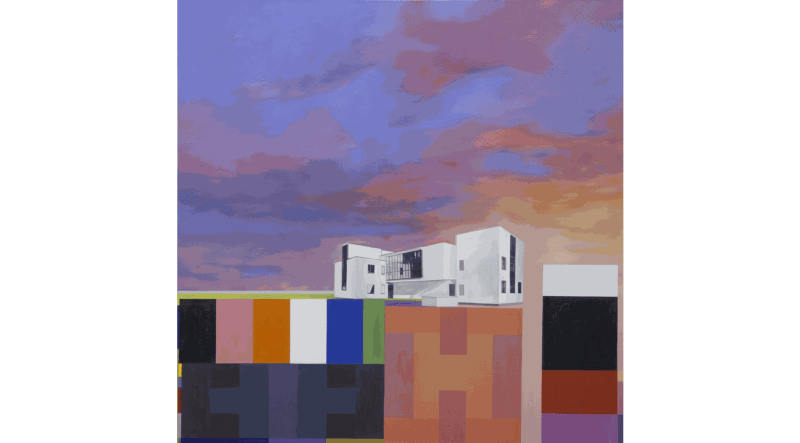Tomorrow-land
Julie Langsam
In her newest exhibition Tomorrow-land, Julie Langsam presents structures built specifically for mid-20th century World’s Fair exhibitions: Philips Pavilion designed by Le Corbusier and Iannis Xenakis, the Tent of Tomorrow & Observation Towers by Philip Johnson and Habitat by Moshe Safdie. In choosing these structures Langsam brings an additional level of engagement to her ongoing exploration into how our ideals as a society are manifest in our collective culture.
In addition to the on-going ‘landscape’ series, Langsam continues to introduce new structures to her body of architectural scenes. Small brightly-colored paintings of floor plans assert the abstract qualities of the architectural blueprint, a two-dimensional depiction of a three-dimensional space. A large collaged floor piece made out of carpet depicts the floor plan of the Director’s Housedesigned by Walter Gropius in Dessau, Germany for the Bauhaus school. Color in these works is chosen through a random system.
In a series of drawings presented in a grid, walls are redacted and covered, [parts of buildings and the adjacent landscape] are replaced with a field of graphite gray. This [simultaneous veiling and overlay] conveys an absence, a void to be filled, but also embodies a curious push/pull effect: the graphic blocking and blotting out of surfaces serves as an intermediary screen that disrupts a structural coherence in reading these pictures. Gray squares, rectangles, trapezoids jump from drawing to drawing. While these images appear historically distant, they are also reanimated.
Langsam’s work playfully negotiates and questions the legacy of modernism on contemporary culture. Representations of toxic landscapes reference the painterly sublime, serving as the ground for modernist architectural marvels, structures that evoke notions of failed utopias. Her work is rendered in a curious flatness, where edges of iconic formalist, modernist paintings are flanked against photographic representations of the building. For Langsam, the canon appears less as a ‘barricade to storm than a ruin to pick through. The works presented suggest an attempt to navigate multiple legacies at once negotiating personal memory with art historical and institutional history.






